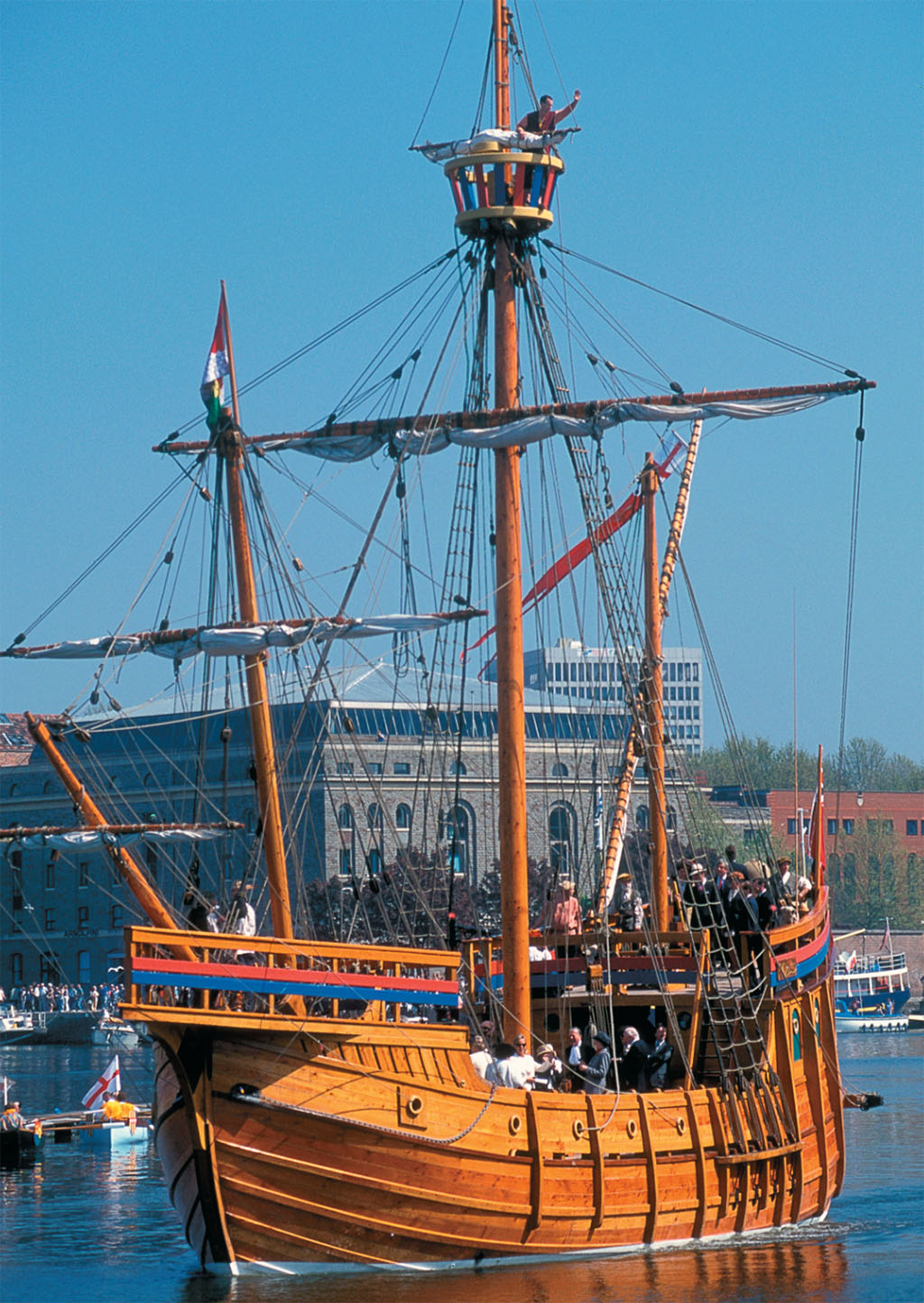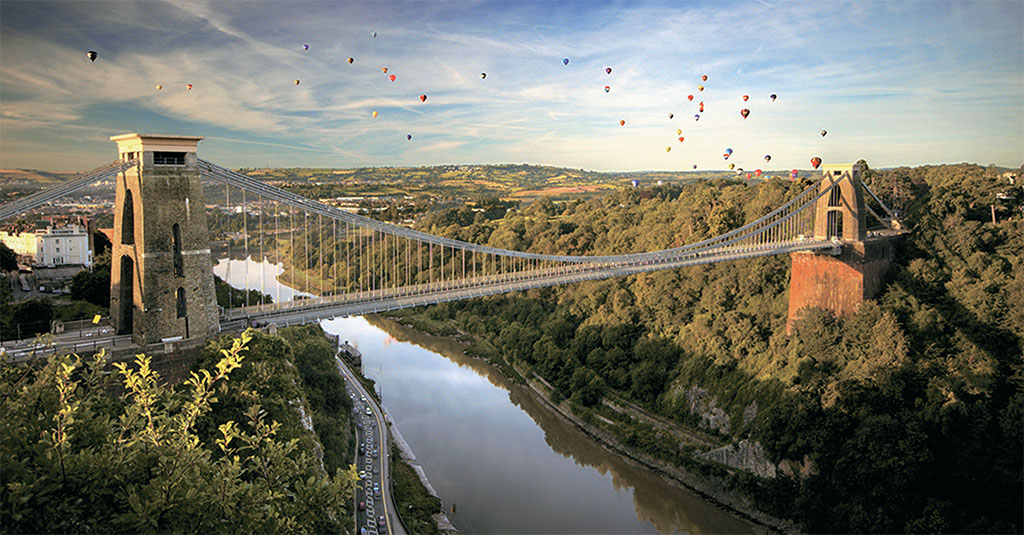
Bristol CathedralGetty
Once one of England’s largest cities, the ancient port has been for centuries a lively haunt of merchants, adventurers, pioneers, and inventors.
Hunky-dory, fine and dandy—as cute expressions go, they’re perfectly tickety-boo. But they don’t quite convey the brusque efficiency of “All Shipshape and Bristol Fashion.” The latter, firmly anchored in centuries-old reputation, recalls when Bristol-built ships were famed far and wide for their skillful, sturdy construction; their crews stood at the ready, everything stowed, to set sail from the southwest port.
Methinks, from my residence in the city in the early 1990s and many subsequent visits, that as an insight into the character of Bristol, the saying resonates in a far broader sense than the literally maritime. While neighboring Bath, around 15 minutes away by train, is a genteel, fine-and-dandy place, a spa where visitors have long gone to frolic, Bristol has a more workaday stamp—the historic haunt of merchants, adventurers, pioneers, and inventors. Creativity has traditionally been welded to technology and honed to a commercial edge.
A settlement grew up between the rivers Avon and Frome, just six miles from the Bristol Channel, in Anglo-Saxon times. Called Brig-stow, the place of a bridge, its potential as a trading post and port were soon exploited. By the 13th century, it was a boomtown, exporting Cotswold wool.
As the Middle Ages ebbed away, Bristol merchants and adventurers, pirates, and privateers traded and tussled with Spain, Portugal, the Mediterranean, and other enticing destinations. Cloth shipped out, wine and other exotica poured in—medieval cellars still exist beneath the city. In 1497, with sponsorship from local merchants, John Cabot famously set sail aboard Matthew on a voyage of discovery and stumbled across Newfoundland.
Amid all the mercantile excitement, the 18th century saw the rise of Bristol’s regrettable involvement in the slave trade; this, too, was the period of author/adventurer Daniel Defoe’s visit to Bristol and his sour observation of “souls engrossed with lucre.”
Yet local magnates proved great benefactors through the ages, and their legacies still stand firm in Bristol’s architecture. Shipping merchant Edward Colston, to name but one, founded the much-respected independent Colston’s School in 1710, and bestowed thousands of pounds on almshouses, workhouses and churches.
Indeed, Bristol is a bustling, even unruly, panorama of all sorts of architectural styles that vie to tell the story of their respective eras: from medieval, to Georgian and Victorian landmarks, to 21st-century developments.
Today, the mix of creativity, technological expertise and diversity on which the city prides itself has helped at least some of its 400,000-plus population to weather the waves of recession. On the one hand, you have the likes of Airbus, BAE and Rolls-Royce designing and producing aircraft components and defense equipment; on the other, there’s Aardman Animations, Oscar-winning creators of the Wallace and Gromit films.

COURTESY OF DESTINATION BRISTOL
If you haven’t been to Bristol for a while, you’ll be surprised by some rapid transformations. The arrival point for many is Bristol Temple Meads train station, where Isambard Kingdom Brunel’s Tudor Gothic Revival old terminus still bravely salutes the Victorian age of rail—and awaits another use after the British Empire and Commonwealth Museum recently moved out. All around, the vast new office development that is Temple Quay draws a new city picture in glass, smart curves and bold lines.
A fun way to travel to the city center is via waterbus along the Avon (throughout the day at weekends/holidays, otherwise at commuter times: www.bristolferry.com). Then, for more of dynamic 21st-century Bristol, head for Cabot Circus. If Britain’s route out of recession is through consumer spending, this new £500 million-plus shopping and leisure quarter sets an enthusiastic example. It’s awash with lucre, lattes, and lunching, Harvey Nichols, House of Fraser, and more than 100 other outlets happy to lighten your purse. Even a nonshopaholic like me can admire its three-tiered splendor and shell-shaped glass roof, kept birdnest-free by a Harris hawk.
Perhaps the real spot to start an exploration of Bristol, however, is the historic harborside. Getting from A to B in the heart of the city, you will run the gantlet of swirling traffic in places, but it’s better controlled than it used to be. You can walk to all the main sights. Bristol’s port operation has long since moved to Avonmouth—the Avon’s tidal range and bends had always been a challenge to large vessels. So the whole central harborside now reverberates to a trendy vibe of prestigious offices, bijou apartments, eateries and attractions.
The highlight among the latter has to be SS Great Britain, at 322 feet long the largest ship in the world when it was launched in 1843, and the first screw-propelled, iron steamship to cross the Atlantic. Its maiden trip from Liverpool to New York in 1845 took 14 days, 21 hours, and eager waiting crowds paid 25 cents a head to clamber aboard for a look; a further 12 cents permitted a peek at the engine room.
After more than one million miles of seagoing life, and a famous salvage and restoration, she rests appropriately in the very dry dock where she was built. You can descend below the protective glass “sea” to inspect her hull, while her re-created engine, once fuelled by coal-shovelling stokers working 24/7, brings to life the nitty-gritty below decks. Most memorable for me, moving from cabin to cabin, are the true-life stories of erstwhile passengers, many of whom left England for a “better life” in Australia. Births and deaths of babies, toe-gnawing rats, the sight and noise of gaggles of animals being slaughtered for dinner—journeys were epic and not for the fainthearted.
Read more
Great Britain’s builder, the rumpled, cigar-smoking workaholic Isambard Kingdom Brunel, was, without doubt, one of England’s greatest engineers. He embodied the Victorian spirit of progress and gave Bristol some of its most-recognized features. With his Great Western Railway terminus and ship ticked off the list, go for the hat trick by hopping onto a boat for a tour along the river to the Avon Gorge: His elegant suspension bridge, the 702-foot link between the cliffs 245 feet above, is as dramatic proof as any that creativity married to technology can produce beautiful offspring.
Also, along harborside, Anchor and Millennium Squares come into their own in summer when street performers make the most of the generous space. Statues, sculptures, and artworks have sprung up. There are rippling water terraces, runway lights inspired by an analemma and famous faces from Bristol’s past: These include a life-sized bronze of Cary Grant, or plain Archibald Leach as he was known in his hometown.
Tourism agencies these days love to divide cities into “quarters”—there are usually five or more of them—that ready-wrap nuances of character into bite-sized chunks. In fact, Bristol’s “districts” (six at the last count) do help to focus a visit. So, from Harborside, it’s a few minutes walk to Bristol’s “Old City,” which is typified by grand 18th-19th century buildings, cobbled streets, and peep-up alleyways around Broad Street and Corn Street. You can just imagine merchants moving between the noble Corn Exchange, coffee shops, and back to the quayside. There’s still a mercantile buzz on Corn Street, though I’ve yet to see anyone exchange money on the brass Nails, or trading tables, that date from the 17th century: Hence “paying on the nail.”
Alongside bars and banks, the covered and open-air markets around here feature everything from handcrafted jewelry to artisan food. I usually find one or two books to buy from the antiquarian/second-hand dealers.
Continuing on, we come to the Georgian Theatre Royal, hunkered down on cobbled King Street. It’s an atmospheric place to catch a play, with a star-studded ceiling. Local merchants dug deep into their pockets to finance the building in 1766, and 50 leading benefactors were each given a silver token that allowed the bearer free attendance at performances—a right still honored today. Fifty more, freshly minted solid silver coins are promised in acknowledgment for “substantial contributions” to current planned refurbishments.
A few steps away is the black-and-white 17th-century Llandoger Trow pub, so named after the sailing barges that once plied between Bristol and Wales. The watering-hole is said to be the model for the Admiral Benbow in Robert Louis Stevenson’s Treasure Island and is rather old-world with beams, dark rooms and decently priced ales. It's outdoor seating often merges with that of The Old Duke opposite, where live jazz and blues shake the air every night of the week. King Street isn’t quiet after dark!
One of the largest parish churches in England, 12th-century St. Mary Redcliffe is where Bristol’s seafaring merchants began and concluded their voyages at the shrine of Our Lady of Redcliffe.
Neighboring Queen Square, a fine vignette of Georgian architecture, is home to many businesses, and also where I was once offered a traineeship as an accountant. Dear reader, I opted for the penury of writing instead.

GARY NEWMAN
Reset your compass and take a look at “Central Bristol,” the city’s shopping center focused on Broadmead, the Mall, and Cabot Circus. My biggest tip is to seek out the New Room (access via Broadmead or Horsefair courtyards), the oldest Methodist chapel in the world.
Clifton and West End, too, has its religious treasure, in the form of Bristol Cathedral. On my way there these days I feel a nostalgic pang for Harvey’s on Denmark Street, an erstwhile restaurant in a medieval cellar complex adjoining a museum of wine. John Harvey imported liquor into Bristol in the 19th century and created the world-famous Harvey’s Bristol Cream sherry. The brand continues, but the eatery and museum have gone; instead, you’ll find a Chinese restaurant—a sign of the cosmopolitan times.
Bristol Cathedral’s chief claim to architectural fame here is that it’s a prime example of a “hall church”: That is, the nave, choir and aisles reach to the same height, creating a very large hall. The best time to visit, as for most cathedrals, is when choral evensong fills out the airy spaces with a resonance that lifts you free of the daily hubbub.
* Originally published in 2016. Updated in 2023.





Comments